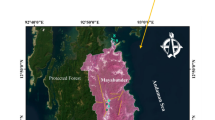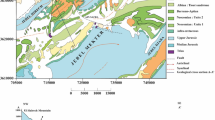Abstract
Twenty-nine dug well samples have been collected from the Gambhir River basin in the Bharatpur District of Rajasthan State in India for hydrogeochemical study to understand the sources of dissolved ions and assess the chemical quality of the water. Broadly speaking, the groundwaters have a chemical composition within the permissible limits suggested for drinking water. Nitrate is higher than the acceptable limit in some samples, due to the use of fertilizers. Graphical treatment of the major ion chemistry helps in deciphering the chemical characteristics of groundwaters, which may then be used for grouping the samples to identify the trends of the chemical alteration of the meteoric water. Four groups have been identified in the Gambhir River basin groundwater system: (1) HCO3 enriched, (2) mixed type, (3) alkali-rich, high TDS type, and (4) HCO3 deficient. Possible aqueous species have been identified for these four groups of samples. In groups I and II, the species are Ca (HCO3)2, Mg (HCO3)2, NaCl, Na2SO4 and NaHCO3. Group III, in addition to these species, has abundance of KCl. Group IV has Ca (HCO3)2, NaCl, CaSO4, and rather rare species such as CaCl2, MgCl2 and MgSO4. Interpretation of the data reveals that feldspar and pyrite weathering reactions do not play a significant role in giving groundwaters their observed chemical characteristics. Groups I and II samples have evidently been derived by dissolution of surface salts, whereas groups III and IV groundwaters suggest dissolution of a marine evaporite sequence similar to the one known to exist to the west of the study area, unconformably overlying the rocks of the Delhi Super Group. There are indications that joints play an important role in segregating groundwaters with different chemical characteristics.











Similar content being viewed by others
References
Back W (1966) Hydrochemical facies and groundwater flow pattern in northern part of Atlantic Coastal Plain. US Geol Surv Prof Pap 498A
Bartarya SK (1993) Hydrochemistry and rock weathering in a sub-tropical Lesser Himalayan river basin in Kumaun, India. J Hydrol 146:149–174
Bhatt KB, Saklani S (1996) Hydrogeochemistry of the Upper Ganges River, India. J Geol Soc India 48:171–182
CGWB (1996) Groundwater resources and development potential of Bharatpur Rajasthan. Tech Rep Central Groundwater Board (CGWB), western region, Jaipur
Das Gupta, Kumar SP, Ramchandra V, Jai Ram MS (1988) A frame work of the Nagaur-Ganganagar evaporites basin Rajasthan. Indian Miner 42(1):57–64
Datta PS, Tyagi SK (1996) Major ion chemistry of groundwater Delhi area: chemical weathering processes and groundwater flow regime. J Geol Soc India 47(2):179–188
Datta S, Malhotra VJ (1982) Groundwater resources development potential of Sawai Madhopur district Rajasthan. Tech Rep CGWB, western region, Jaipur
Datta S, Rao MKM (1981) Groundwater resources and development potential of Bharatpur district Rajasthan. Tech Rep CGWB, western region, Jaipur
Dethier DP (1988) A hydrochemical model for stream chemistry, cascade range, Washington U.S.A. Earth Surface Processes Land Forms 13:321–333
Drever JI (1982) The geochemistry of natural waters. Prentice-Hall, Englewood Cliffs, NJ
Faure G (1998) Principles and applications of geochemistry, 2nd edn. Prentice-Hall, Englewood Cliffs, NJ
Fournier RO, Potter RW (1998) A revised and expanded silica (quartz) geothermometer. Geotherm Res Council Bull II:3–9
Karanth KR (1997) Groundwater assessment, development and management. Tata McGraw-Hill, New Delhi
Langelier WF, Ludwig HF (1942) Graphic method for indicating the mineral character of natural water. J Am Water Works Assoc 34(3):335–352
Singh SP (1982) Stratigraphy of Delhi Supergroup in Bayana sub basin northeastern Rajasthan. Records Geol Surv India 112(7):46–62
Stallard RF, Edmond JM (1983) Geochemistry of Amazon River: the influence of the geology and weathering environment on the dissolved load. J Geophys Res 88:9671–9688
Subba Rao N (2001) Geochemistry of groundwater in parts of Guntur district, Andhra Pradesh, India. Environ Geol 41:552–562
Acknowledgement
The authors are grateful to the Chairman of the Department of Geology for providing facilities to carry out the work. The financial support in the form of a minor research project from Aligarh Muslim University is thankfully acknowledged.
Author information
Authors and Affiliations
Corresponding author
Rights and permissions
About this article
Cite this article
Umar, R., Absar, A. Chemical characteristics of groundwater in parts of the Gambhir River basin, Bharatpur District, Rajasthan, India. Env Geol 44, 535–544 (2003). https://doi.org/10.1007/s00254-003-0789-y
Received:
Accepted:
Published:
Issue Date:
DOI: https://doi.org/10.1007/s00254-003-0789-y




